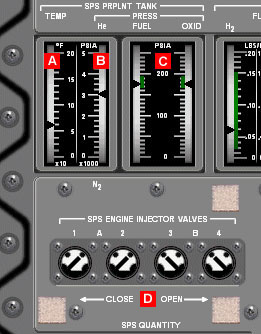Service Propulsion System
The Service Propulsion System (SPS) is the Command/Service Module main engine and provides the impulse for all velocity changes (ΔVs) throughout a mission and the SPS abort capability after the launch escape tower is jettisoned. The engine uses Aerozine 50 (hydrazine/UDMH) fuel and nitrogen tetroxide oxidizer and has a maximum thrust of 20,500 lbf (91.2 kN). This hypergolic fuel combination is pressurized with helium during thrusting periods, so no propellant pump is needed. The propellant flow from the tanks to the thrust chamber is controlled by the engine injector valves, which are pneumatically controlled with nitrogen. The engine is gimbaled to allow thrust vector control during a burn.
Quickstart mode
In Quickstart mode the SPS engine works like a normal Orbiter main thruster. The engine can be throttled with the keyboard or Orbiter's joystick control as usual, although the real SPS engine isn't throttleable. The Interplanetary MFD (IMFD) autoburn program can be used, too. It's not necessary to use the panel displays and controls, the Orbiter engine displays can be used though the panel displays are enabled normally.
Engine thrust on/off logic

In Standard mode and Virtual AGC mode the SPS engine works like the real thing, that means as specified in the original documentationAOH. So the real SPS engine isn't throttleable, it only can be turned on or off by opening or closing one of the two pairs of engine injector valves D (bipropellant valve systems A or B) pneumatically. The gaseous nitrogen pressure [X] of valve system A and B can be monitored by switching the SPS-PRESS IND switch to N2 A or N2 B [X].
Thrust vector control
Propellant pressurisation
Propellant utilization
Thermal control
<biblio force=false>
#References </biblio>